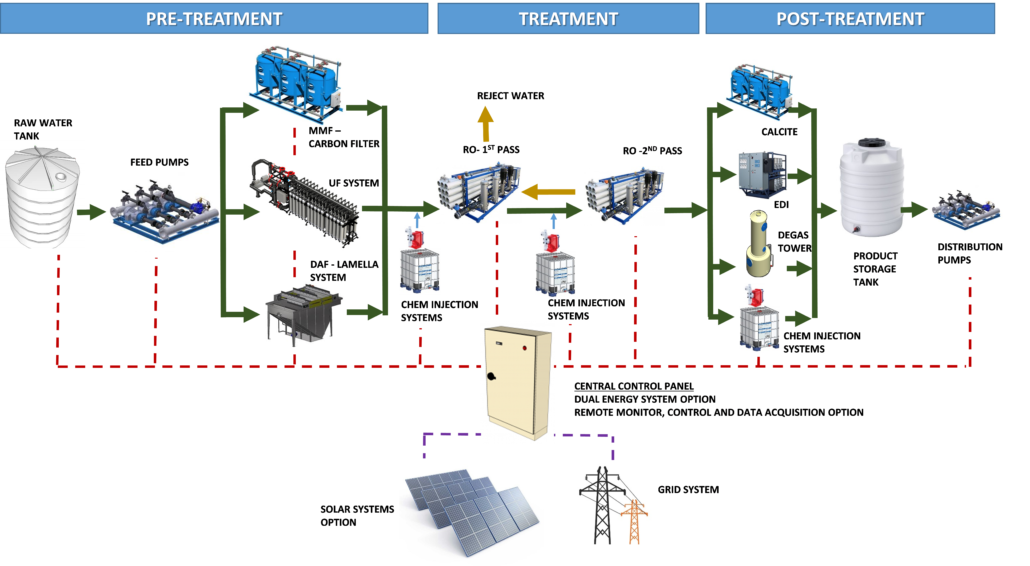HIGH TDS REDUCTION
WHAT IS HIGH TDS WATER?
There are potential health effects caused due to high TDS content in drinking water. The hard water will taste bitter, salty, or metallic and may have unpleasant odors. High TDS water is less thirst quenching.
High TDS interferes with the taste of foods and beverages, and makes them less desirable to consume. Some of the individual mineral salts such as Nitrates, Sodium, Sulfates, Barium, Cadmium, Copper and Fluoride that make up TDS pose a variety of health hazards such as causing stiffness in the joints, hardening of the arteries, kidney stones, gall stones and blockages of arteries, microscopic capillaries and other passages in which liquids flow through our entire body.
Sustainability of good health of living organisms depends upon the purity of water. Because of its inherent dissolution capacity, water naturally picks up minerals and salt present in the earth crust during the runoff and percolation process. Water is used for several purposes by human beings and the level of purity of water consumed is very crucial as it has a direct and telling effect on health.
HOW TO MAKE LOW TDS WATER?
In order to successfully remove most of the TDS content in water, the treatment process should have this stages:
- Filtration, for removal of suspended solids, odor, color and protect the membrane filtration system
- Reverse Osmosis, a two (2) pass system takes place to remove a high percentage of TDS. The product of the first pass feeds the second pass; and the reject water of the second pass acts as part of the feed of the first one
- Post-treatment, this process will depend of the usage of the water but it can be a remineralization system, chemical injection, etc.

OUR SOLUTION
Typically we recommend the following steps:

Complete flowchart for High TDS Reduction process showing the ADVANCEES systems. This flowchart vary based on raw water quality and customer’s requirement. Many options and combinations are possible, the best solution needs to accommodate the minimum life cycle cost such as low operating cost, low maintenance, easy to operate and monitor.

What Is TDS in Water?
Total Dissolved Solids (TDS) refer to the combined content of all inorganic and organic substances present in water. These include minerals, salts, metals, and a variety of dissolved substances commonly found in natural sources, municipal supplies, or industrial discharge. TDS levels are typically measured in parts per million (ppm), and high TDS can impact the taste, appearance, and overall quality of water.
While some minerals in water are essential for health, excessive TDS can make water unsuitable for drinking, damage appliances, and reduce the effectiveness of industrial processes.
Why TDS Reduction Is Important
Reducing high TDS levels is critical to ensure water is clean, safe, and suitable for its intended use—whether residential, commercial, or industrial. Elevated TDS can:
- Affect the taste and odor of drinking water
- Shorten the lifespan of plumbing systems and household appliances
- Cause scale buildup in pipes and boilers
- Interfere with product manufacturing processes
- Increase maintenance costs
By lowering TDS, water becomes more palatable and safer while also supporting better performance in systems that rely on clean water, from drinking dispensers to pharmaceutical production.
Best Methods for High TDS Reduction
Advanced water treatment systems typically use a combination of technologies to reduce TDS effectively. The most widely used solutions include:
Reverse Osmosis Systems
Reverse osmosis (RO) is the most effective method for reducing TDS in water. This system forces water through a semi-permeable membrane, removing up to 99% of dissolved solids, salts, and other impurities. RO systems are ideal for residential drinking water filtration, commercial beverage production, and industrial process water. ADVANCEES RO units are engineered for high efficiency, long service life, and minimal waste output.
Filtration Techniques
While traditional filtration methods like activated carbon or sand filters are not sufficient for removing high TDS levels, they serve as essential pre-treatment steps. Filtration helps eliminate large particles, chlorine, and organic contaminants that could damage reverse osmosis membranes or reduce system performance. ADVANCEES systems incorporate these techniques as part of a multi-stage purification process.
Post-Treatment Options
After TDS has been significantly reduced through RO and filtration, post-treatment may be necessary depending on the application. This can include remineralization (to improve taste and pH), UV disinfection (for biological safety), or chemical dosing (for corrosion control). Post-treatment ensures that the final water quality meets specific regulatory or industrial standards.
Why Choose Advancees for TDS Treatment?
- Commercial and industrial clients benefit from improved process efficiency and reduced scale-related downtime.
- Environmental advantage: Our systems use less energy and produce less waste than traditional alternatives.
By choosing ADVANCEES, you’re not just investing in a water treatment system—you’re securing clean, consistent, and cost-effective water for years to come.
Explore Our Reverse Osmosis Solutions
Ready to find the right system for your water treatment needs? Discover our full range of Reverse Osmosis Products—from seawater and brackish water systems to containerized and solar-powered units. Explore our RO systems now and see how ADVANCEES delivers efficiency, reliability, and innovation for every application.
